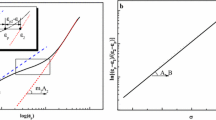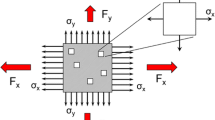Abstract
For better modeling plane-stress anisotropic plasticity of steel sheets, a direct calibration method is proposed and detailed for establishing a positive and convex sixth-order homogeneous polynomial yield function with up to sixteen independent material constants. The calibration method incorporates parameter identification, convexity testing, and if needed, an adjustment of an initially calibrated but non-convex yield function toward a convex one. Some advantages of the calibration method include (i) a systematic solution of only linear equations for the sixteen material constants of a steel sheet with various degrees of planar anisotropy, (ii) a practical numerical implementation of the necessary and sufficient conditions for convexity certification of the calibrated or adjusted yield function, and (iii) an incremental procedure using a parameterized version of the initially calibrated and non-convex yield function that can always lead to an approximate sixth-order yield function with guaranteed convexity. Results of applying the proposed calibration method to successfully obtain convex sixth-order yield functions are presented for three steel sheets with experimental measurement inputs from various types and numbers per type of uniaxial and biaxial tension tests.
Similar content being viewed by others
Abbreviations
- x, y, z :
-
The orthotropic material symmetry axes corresponding to the rolling (RD), transverse (TD), and normal (ND) directions of a thin sheet metal
- \(\sigma _x\), \(\sigma _y\), \(\tau _{xy}\) :
-
Three in-plane Cartesian (two normal and one shear) components of an applied Cauchy stress \(\pmb {\sigma }\) in the orthotropic coordinate system of the sheet metal
- \(\varPhi _2\), \(A_1\),..., \(A_4\) :
-
Hill’s 1948 quadratic anisotropic yield function [9] in plane stress and its four material constants
- \(\varPhi _4\), \(A_1\),..., \(A_9\) :
-
Gotoh’s 1977 fourth-order anisotropic yield function [6] in Cartesian stress components (\(\sigma _x\), \(\sigma _y\), \(\tau _{xy}\)) and its nine material constants
- \(\varPhi _6\), \(A_1\),..., \(A_{16}\) :
-
The sixth-order homogeneous polynomial anisotropic yield function in Cartesian stress components (\(\sigma _x\), \(\sigma _y\), \(\tau _{xy}\)) and its sixteen material constants
- \(\sigma _1\), \(\sigma _2\), \(\theta \) :
-
The so-called intrinsic variables of an applied plane stress \(\pmb {\sigma }\) according to Hill [12, 13], namely, the in-plane principal stresses (\(\sigma _1,\sigma _2\)) and the loading orientation angle \(\theta \) between \(\sigma _1 (\ge \sigma _2)\) and the rolling direction of the sheet metal
- \(\sigma _{\theta }\), \(r_{\theta }\), \(\sigma _b\), \(r_b\) :
-
Yield stresses and plastic strain ratios under uniaxial tension (\(\sigma _1=\sigma _\theta > 0,\sigma _2=0\)) at the loading orientation angle \(\theta \); and yield stress and plastic strain ratio under equal biaxial tension (\(\sigma _1=\sigma _2=\sigma _b>0\))
- \(\sigma _{p\theta }\), \(\sigma _{s\theta }\) :
-
Yield stresses under near plane-strain tension (\(\sigma _1=2\sigma _2=\sigma _{p\theta }>0\)) and under pure shear stress (\(\sigma _1=-\sigma _2=\sigma _{s\theta }>0\)) at the loading orientation angle \(\theta \)
- \(\phi _{6}\), \(F(\theta ), G(\theta ),H(\theta ), N(\theta )\) :
-
The sixth-order yield function recast in intrinsic variables in a compact form of seven homogeneous principal stress terms and its four in-plane anisotropic functions. \(F_0\),...,\(F_6\), and so forth are the 25 nonzero Fourier cosine series coefficients of those four functions
- \(\varPsi _{6A}\), \(\varPsi _{6B}\), \(\varPsi _{6C}\) :
-
Three sub-determinants or leading principal minors of the Hessian matrix of the sixth-order yield function \(\varPhi _6\) in Cartesian stress components (\(\sigma _x\), \(\sigma _y\), \(\tau _{xy}\))
- \(\psi _{6A}\), \(\psi _{6B}\), \(\psi _{6C}\) :
-
Three sub-determinants \(\varPsi _{6A}\), \(\varPsi _{6B}\), \(\varPsi _{6C}\) of the Hessian matrix of the sixth-order yield function \(\varPhi _6\) recast in intrinsic variables (\(\sigma _1\), \(\sigma _2\), \(\theta \))
- \(\rho \), \(\omega \) :
-
The polar coordinates for the two principal stresses \(\sigma _1\) and \(\sigma _2\)
References
Ahmadi, A., Olshevsky, A., Parrilo, P., Tsitsiklis, J.: NP-hardness of deciding convexity of quartic polynomials and related problems. Math. Progr. Ser. A 137, 453–476 (2013)
Aretz, H., Hopperstad, O.S., Lademo, O.G.: Yield function calibration for orthotropic sheet metals based on uniaxial and plane strain tensile tests. J. Mat. Process. Technol. 186, 221–235 (2007)
Barlat, F., Yoon, J.W., Cazacu, O.: On linear transformations of stress tensors for the description of plastic anisotropy. Int. J. Plast. 23(3), 876–896 (2007)
Carrell, J.B.: Fundamentals of Linear Algebra, pp. 363–364. http://www.math.ubc.ca/~carrell/NB.pdf (2005). Accessed 26 Apr 2017
Drucker, D.: Relations of experiments to mathematical theories of plasticity. J. Appl. Mech. 16, 349–357 (1949)
Gotoh, M.: A theory of plastic anisotropy based on a yield function of fourth order (plane stress state)-I. Int. J. Mech. Sci. 19, 505–512 (1977)
Gotoh, M.: A theory of plastic anisotropy based on a yield function of fourth order (plane stress state)-II. Int. J. Mech. Sci. 19, 513–520 (1977)
Hershey, A.: The plasticity of an isotropic aggregate of anisotropic face centred cubic crystals. J. Appl. Mech. Trans. ASME 21, 241–249 (1954)
Hill, R.: A theory of the yielding and plastic flow of anisotropic metals. Proc. R. Soc. Lond. A193, 281–297 (1948)
Hill, R.: The Mathematical Theory of Plasticity, p. 330. Clarendon Press, Oxford (1950)
Hill, R.: Theoretical plasticity of textured aggregates. Math. Proc. Camb. Philos. Soc. 85, 179–191 (1979)
Hill, R.: Basic stress analysis of hyperbolic regimes in plastic media. Math. Proc. Camb. Philos. Soc 88, 359–369 (1980)
Hill, R.: Constitutive modeling of orthotropic plasticity in sheet metals. J. Mech. Phys. Solids 38, 403–417 (1990)
Hosford, W.F.: A generalized isotropic yield criterion. J. Appl. Mech. Trans. ASME 39, 607–609 (1972)
Hosford, W.F.: Comments on anisotropic yield criteria. Int. J. Mech. Sci. 27, 423–427 (1985)
Hosford, W.F.: The Mechanics of Crystals and Textured Polycrystals. Oxford University Press, Oxford (1993)
Hu, W.: An orthotropic yield criterion in a 3-D general stress state. Int. J. Plast. 21, 1771–1796 (2005)
Karafillis, A.P., Boyce, M.C.: A general anisotropic yield criterion using bounds and a transformation weighting tensor. J. Mech. Phys. Solids 41(12), 1859–1886 (1993)
Logan, R., Hosford, W.: Upper-bound anisotropic yield locus calculations assuming pencil glide. Int. J. Mech. Sci. 22, 419–430 (1980)
Savoie, J., MacEwen, S.R.: A sixth order inverse potential function for incorporation of crystallographic texture into predictions of properties of aluminum sheet. Textures Microstruct. 26–27, 495–512 (1996)
Soare, S., Barlat, F.: Convex polynomial yield functions. J. Mech. Phys. Solids 58, 1804–1818 (2010)
Soare, S., Yoon, J.W., Cazacu, O.: On the use of homogeneous polynomials to develop anisotropic yield functions with applications to sheet forming. Int. J. Plast. 24(6), 915–944 (2008)
Tong, W.: Application of Gotoh’s orthotropic yield function for modeling advanced high-strength steel sheets. ASME J. Manuf. Sci. Eng. 138, 094502-1–094502-5 (2016)
Tong, W.: Generalized fourth-order Hill’s 1979 yield function for modeling sheet metals in plane stress. Acta Mech. 227(10), 2719–2733 (2016)
Tong, W.: On the parameter identification of polynomial anisotropic yield functions. ASME J. Manuf. Sci. Eng. 138, 071002-1–071002-8 (2016)
Tong, W., Alharbi, M.: Comparative evaluation of non-associated quadratic and associated quartic plasticity models for orthotropic sheet metals. Int. J. Solids Struct. 128, 133–148 (2017)
Van Houtte, P., Van Bael, A.: Convex plastic potentials of fourth and sixth rank for anisotropic materials. Int. J. Plast. 20, 1505–1524 (2004)
Vegter, H., ten Horn, C., An, Y., Atzema, E., Pijlman, H., den Boogaard, T., Huetink, H.: Characterization and modelling of plastic material behaviour and its application in sheet metal forming simulation. In: Onate, E., Owen, D.R.J. (eds.) Proceedings of VII International Conference on Plasticity. Barcelona (2003)
Yang, W.: A useful theorem for constructing convex yield function. J. Appl. Mech. ASME 47, 301–303 (1980)
Yoshida, F., Hamasaki, H., Uemori, T.: A user-friendly 3D yield function to describe anisotropy of steel sheets. Int. J. Plast. 45, 119–139 (2013)
Yoshida, F., Hamasaki, H., Uemori, T.: Modeling of anisotropic hardening of sheet metals including description of the Bauschinger effect. Int. J. Plast. 75, 170–188 (2015)
Zhou, Y., Jonas, J., Savoie, J., Makinde, A., MacEwen, S.: Effect of texture on earing in FCC metals: finite element simulations. Int. J. Plast. 14(1–3), 117–138 (1998)
Author information
Authors and Affiliations
Corresponding author
Rights and permissions
About this article
Cite this article
Tong, W. Calibration of a complete homogeneous polynomial yield function of six degrees for modeling orthotropic steel sheets. Acta Mech 229, 2495–2519 (2018). https://doi.org/10.1007/s00707-018-2113-7
Received:
Revised:
Published:
Issue Date:
DOI: https://doi.org/10.1007/s00707-018-2113-7




